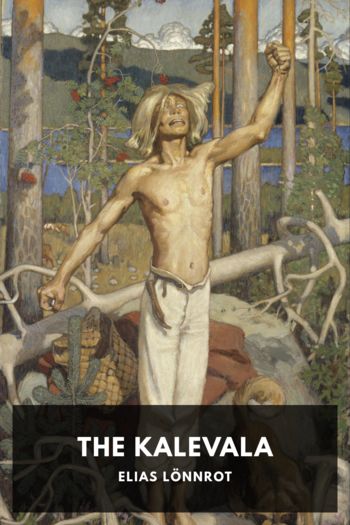The Kalevala, Elias Lönnrot [easy novels to read TXT] 📗

- Author: Elias Lönnrot
Book online «The Kalevala, Elias Lönnrot [easy novels to read TXT] 📗». Author Elias Lönnrot
Perhaps it should be stated here that the copper, so often mentioned in the Kalevala, when taken literally, was probably bronze, or “hardened copper,” the amount and quality of the alloy used being not now known. The prehistoric races of Europe were acquainted with bronze implements.
It may be interesting to note in this connection that Canon Isaac Taylor, and Professor Sayce have but very recently awakened great interest in this question, in Europe especially, by the reading of papers before the British Philological Association, in which they argue in favor of the Finnic origin of the Aryans. For this new theory these scholars present exceedingly strong evidence, and they conclude that the time of the separation of the Aryan from the Finnic stock must have been more than five thousand years ago.
The Finnish nation has one of the most sonorous and flexible of languages. Of the cultivated tongues of Europe, the Magyar, or Hungarian, bears the most positive signs of a deep-rooted similarity to the Finnish. Both belong to the Ugrian stock of agglutinative languages, i.e., those which preserve the root most carefully, and effect all changes of grammar by suffixes attached to the original stein. Grimin has shown that both Gothic and Icelandic present traces of Finnish influence.
The musical element of a language, the vowels, are well developed in Finnish, and their due sequence is subject to strict rules of euphony. The dotted ö; (equivalent to the French eu) of the first syllable must be followed by an e or an i. The Finnish, like all Ugrian tongues, admits rhyme, but with reluctance, and prefers alliteration. Their alphabet consists of but nineteen letters, and of these, b, c, d, f, g, are found only in a few foreign words, and many others are never found initial.
One of the characteristic features of this language, and one that is likewise characteristic of the Magyar, Turkish, Mordvin, and other kindred tongues, consists in the frequent use of endearing diminutives. By a series of suffixes to the names of human beings, birds, fishes, trees, plants, stones, metals, and even actions, events, and feelings, diminutives are obtained, which by their form, present the names so made in different colors; they become more naive, more childlike, eventually more roguish, or humorous, or pungent. These traits can scarcely be rendered in English; for, as Robert Ferguson remarks: “The English language is not strong in diminutives, and therefore it lacks some of the most effective means for the expression of affectionate, tender, and familiar relations.” In this respect all translations from the Finnish into English necessarily must fall short of the original. The same might be said of the many emotional interjections in which the Finnish, in common with all Ugrian dialects, abounds. With the exception of these two characteristics of the Ugrian languages, the chief beauties of the Finnish verse admit of an apt rendering into English. The structure of the sentences is very simple indeed, and adverbs and adjectives are used sparingly.
Finnish is the language of a people who live preeminently close to nature, and are at home amongst the animals of the wilderness, beasts and birds, winds, and woods, and waters, falling snows, and flying sands, and rolling rocks, and these are carefully distinguished by corresponding verbs of ever-changing acoustic import. Conscious of the fact that, in a people like the Finns where nature and nature-worship form the centre of all their life, every word connected with the powers and elements of nature must be given its fall value, great care has been taken in rendering these finely shaded verbs. A glance at the mythology of this interesting people will place the import of this remark in better view.
In the earliest age of Suomi, it appears that the people worshiped the conspicuous objects in nature under their respective, sensible forms. All beings were persons. The Sun, Moon, Stars, the Earth, the Air, and the Sea, were to the ancient Finns, living, self-conscious beings. Gradually the existence of invisible agencies and energies was recognized, and these were attributed to superior persons who lived independent of these visible entities, but at the same time were connected with them. The basic idea in Finnish mythology seems to lie in this: that all objects in nature are governed by invisible deities, termed haltiat, regents or genii. These haltiat, like members of the human family, have distinctive bodies and spirits; but the minor ones are somewhat immaterial and formless, and their existences are entirely independent of the objects in which they are particularly interested. They are all immortal, but they rank according to the relative importance of their respective charges. The lower grades of the Finnish gods are sometimes subservient to the deities of greater powers, especially to those who rule respectively the air, the water, the field, and the forest. Thus, Pilajatar, the daughter of the aspen, although as divine as Tapio, the god of the woodlands, is necessarily his servant. One of the most notable characteristics of the Finnish mythology is the interdependence among the gods. “Every deity,” says Castrén, “however petty he may be, rules in his own sphere as a substantial, independent power, or, to speak in the spirit of the Kalevala, as a self-ruling householder. The god of the Polar-star only governs an insignificant





Comments (0)